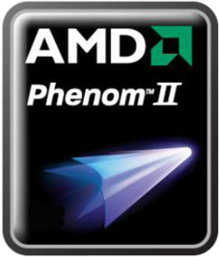Phenom II
 |
|
| Produced | From 2008 to 2012 |
|---|---|
| Marketed by | AMD |
| Designed by | AMD |
| Common manufacturer(s) | |
| Max. CPU clock rate | 2.5 GHz to 3.7 GHz |
| HyperTransport speeds | 1.8 GHz to 2 GHz |
| Min. feature size | 45 nm |
| Instruction set | x86, x86-64, MMX, SSE, SSE2, SSE3, SSE4a |
| Microarchitecture | AMD K10 |
| Cores | 2, 3, 4 or 6 |
| Socket(s) | |
| Predecessor | Phenom |
| Successor | Bulldozer |
| Core name(s) |
|
Phenom II is a family of AMD's multi-core 45 nm processors using the AMD K10 microarchitecture, succeeding the original Phenom. Advanced Micro Devices released the Socket AM2+ version of Phenom II in December 2008, while Socket AM3 versions with DDR3 support, along with an initial batch of triple- and quad-core processors were released on February 9, 2009. Dual-processor systems require Socket F+ for the Quad FX platform. The next-generation Phenom II X6 was released on April 27, 2010.
The Phenom II X4 operates as the processor component of AMD's Dragon Platform, which also includes the 790 series chipset and Radeon HD 4800 series graphics. The Thuban Phenom II X6 is the CPU in the Leo Platform which also includes the AMD 890 chipset and the Radeon HD 5800 series graphics.
The Phenom II triples the shared L3 cache size from 2MB (in the original Phenom line) to 6MB, leading to benchmark performance gains as high as 30%. In another change from the original Phenom, Cool'n'Quiet applies to the processor as a whole, rather than on a per-core basis. AMD implemented this to address the mishandling of threads by Windows Vista, which can cause single-threaded applications to run on a core that idles at half its clock rate. This feature can be disabled through BIOS options on most motherboards, which allows for customization and overclocking. Due to the nature of this feature, it reduces the effectiveness of overclocking the CPU and RAM, but also decreases power consumption and heat output.
Socket AM2+ versions of the Phenom II (920, 940) lack forward-compatibility with Socket AM3.Socket AM3 versions of the Phenom II are backwards-compatible with Socket AM2+, though this is contingent on motherboard manufacturers supplying BIOS updates. In addition to the Phenom II's pin compatibility, the AM3 memory controller supports both DDR2 and DDR3 memory (up to DDR2-1066 and DDR3-1333), allowing existing AM2+ users to upgrade their CPU without changing the motherboard or memory. However, similar to the way the original Phenom handled DDR2-1066, current Phenom II platforms limit the usage of DDR3-1333 to one DIMM per channel; otherwise, the DIMMs are under clocked to DDR3-1066. AMD claims that this behaviour is due to the BIOS, not the memory controller, and plans to address it with a BIOS update. The dual-spec memory controller also gives motherboard manufacturers and system builders the option of pairing AM3 with DDR2, as compared to competing chips from Intel which require DDR3.
...
Wikipedia
